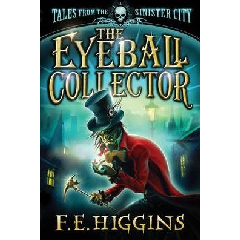- Get link
- X
- Other Apps

The Eyeball Collector by F.E.Higgins is a fictional adventure book. The book has many Victorian England features including the settings (however it isn't known as England) and the clothing. It is about a vengeful boy named Hector. After his family was blackmailed he sought out. Hectors family is interested in lepidoptery; collecting, studying and observing butterflies and moths. Hector used to live a privileged and rich life. As Hector journeys on seeking vengeance, he faces many dark twists and turns on the way. He is continuously filled with dread and disgust at what some people may do. He follows the culprit to Withypitts Hall, a forbidding mansion as warped as its inhabitants and their secret schemes. The ones he holds close to him all warn him not to take this path of revenge however he is consumed by vengeance and ignores these warnings. The longer Hector stays at Withypitts Hall the more disgusted he is.
Overall, I liked this book. I enjoyed how the author put riddles in the story as it got me thinking about them and it offered a break from what was happening. The story is well developed with mysterious events occurring consistently. After reading this book I started to think how cruel and twisted some people can be. Butterflies are often portrayed as beautiful, colourful and stunning creatures however the events that occur in this book are not nice, happy events but instead quite gruesome and disturbing.This book had many words I didn't know and often I had to find definitions although I had an idea of what they meant. The author also wrote messages about greed, how it can consume you and become your downfall. The characters are exaggerated but it makes you think about how people really are.
- Get link
- X
- Other Apps
Popular Posts
A LITERARY CRITIQUE OF THE WHALE RIDER, BY WITI IHIMAERA
Witi Ihimaera, The Whale Rider —International Edition (Reed Publishing, 2003), pp. 154. Ihimaera is arguably the most influential Maori author in existence, publishing the first collection of short stories by a Maori writer called Pounamu Pounamu in 1972. The following year, he followed suit by being the first Maori to author a novel— Tangi. However, his magnum opus is indubitably his 1987 The Whale Rider. Fifteen years later the film adaption was released, with the eminent Niki Caro as the supervising director and Keisha Castle-Hughe's entrancing performance as the protagonist. As one commentator accurately observed, "A film so specific to one area, and grounded so firmly in New Zealand and Maori culture, has enthralled audiences from different countries partly because of the universal theme of heroic triumph over adversity, but mainly because of Castle-Hughes' and [Rawiri] Paratene's stunningly natural and utterly convincin...
Short Stories: WHERE IS DANIEL?
The time was an early morning in the winter of 1941. Falling snow packed onto the hard labourers of Gulag 10 WLA as they begin setting off into the mines and factories somewhere in the far east. Malnourished, mistreated and muddy, the inhabitors of this typical Gulag were kept under strict control of General Victor, who gave harsh punishments to any prisoner who dared riot or worse, insult the government. It was a normal evening. The prisoners were escorted back to the Gulag through the freezing taiga by cattle carriages. They waited in line for their daily rations: Rubbery potatoes, dried bread and lime water. If one behaved well and boasted high production, he/she would sometimes be rewarded with a small knob of fresh corn, a snack the guards would gladly feast on. General Victor was feasting on a large chicken when Archie, or formally, Guard Number One burst into his room reporting misbehaviour between two prisoners. Ben (Guard Number Two) and Mile...
The Book of Heroic Failures
The Book of Heroic Failures By Stephen Pile The Book of Heroic Failures, was written by Stephen Pile and first published in 1979. This book is essentially a collection of hilarious, ironic and unusual people and events. This sole theme is that of ironic failure, each story being anywhere from a few sentences to several paragraphs. The book itself is split into eleven different sections so that the reader may dip in and out of the book at will, which is a very helpful format considering the layout of the stories. My favourite sections include the glory of the stage , stories we failed to pin down and the art of being wrong. From the poet whose footnotes were longer than his poems, to a bill ruling that the value of pi was four, there is no shortage of entertaining stories within this books pages. To those who wish to read only the best of these stories I would advise that you read some of the longer ones as more tends to go wrong, causing a domino...

Comments
Post a Comment